Sunday, 10 July Aix-en-Provence to Valence
Written 17 July 2016
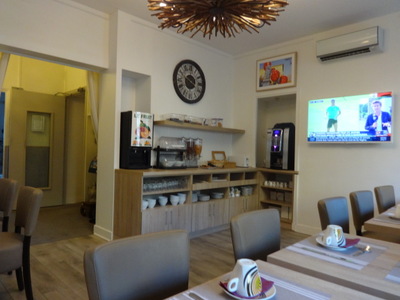
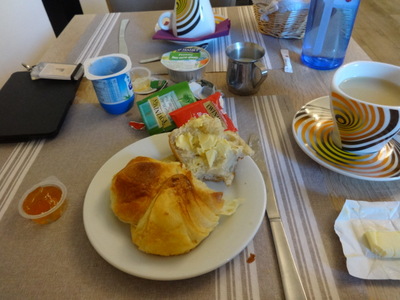 Breakfast at the Concorde comes from this compact little buffet. It's anchored at one end by the coffee machine and at the other by the juice dispenser. In between are croissants, baguette chunks, sliced bread for the toaster, three kinds of cereal, and butter, jam, and nutella. The hostess brings each person a plain yogurt and a single-serve tub of applesauce. No decaf, so I chose tea, and I put apricot jam in my yogurt.
Breakfast at the Concorde comes from this compact little buffet. It's anchored at one end by the coffee machine and at the other by the juice dispenser. In between are croissants, baguette chunks, sliced bread for the toaster, three kinds of cereal, and butter, jam, and nutella. The hostess brings each person a plain yogurt and a single-serve tub of applesauce. No decaf, so I chose tea, and I put apricot jam in my yogurt.
I also thought to bring a little packet of salt with me, because of the annoying habit French hotels have of supplying only unsalted butter.
By purest coincidence, the Hôtel de Caumont Centre d'Art in Aix was featuring a temporary exhibit of the works of British landscape artist william Turner (1775–1851) and his use of color, so we packed our bags, left them with the hotel, and set off to be on the museum's doorstep at opening time.
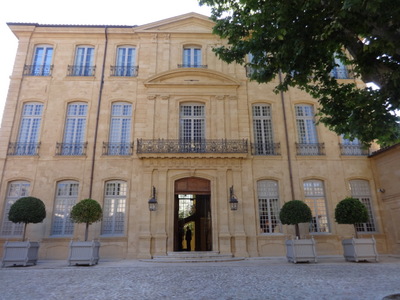
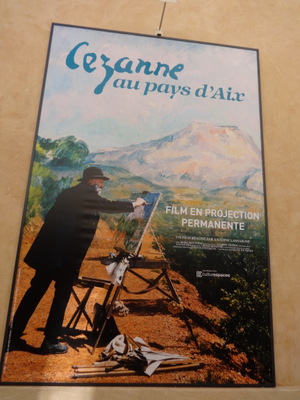 We were there, waiting for the opening gun, when we and the few others waiting with us saw advancing down the street a solid phalanx of at least 60 people, led by a guide in Carnaval Cruise livery. Oh, no! But fortunately, they were only pausing to look through the gates at the building and continued on by without lining up to go in.
We were there, waiting for the opening gun, when we and the few others waiting with us saw advancing down the street a solid phalanx of at least 60 people, led by a guide in Carnaval Cruise livery. Oh, no! But fortunately, they were only pausing to look through the gates at the building and continued on by without lining up to go in.
The photo on the left shows the Hôtel de Caumont. It's a "hotel" in the old-fashioned French sense of private urban home—in the U.S. it would be called the "Caumont Mansion."
The one at the right shows the poster of a film about Cezanne that plays continuously whenever the museum is open. We watched it before we left.
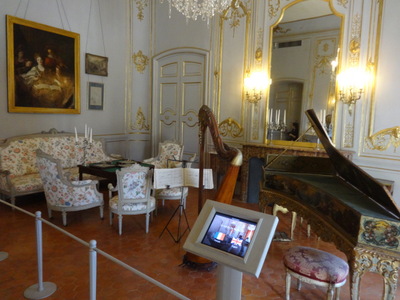
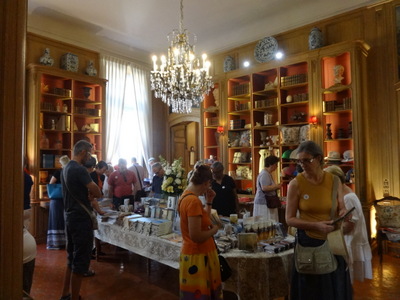 In addition to the Turner exhibit, a couple of furnished rooms of the house itself were open. This one is the music room, and if we'd had time, we could have stood at the little computer terminal, touched the language of our choice, and heard all about its furniture.
In addition to the Turner exhibit, a couple of furnished rooms of the house itself were open. This one is the music room, and if we'd had time, we could have stood at the little computer terminal, touched the language of our choice, and heard all about its furniture.
As it was, we went directly into the Turner exhibit. For once, I got my audioguide in English. It was a French museum, but the artist was British! unfortunately, no photos were allowed, so the exhibit gets short shrift here—no way I could describe it usefully without images. I really liked his earlier pencil and watercolor architectural and landscape works. Apparently, he was a pioneer in the use of color, particularly newly available paint colors, like chrome yellow and cobalt blue. He experimented with landscapes composed entirely of areas of color, with no lines at all. I liked those as well, but not as well as the earlier pencil and watercolor work. The metal tube of paint with a screw cap first appeared in 1842, and Turner was a chronic early adopter of things like that.
We didn't take time to explore the museum's other furnished rooms, but the photo at the right of the giftshop gives you an idea of the interiors.
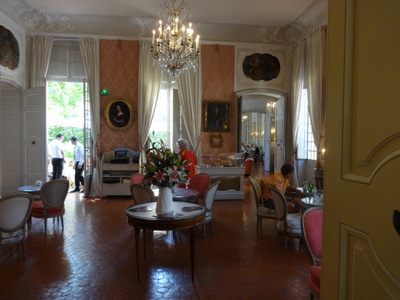
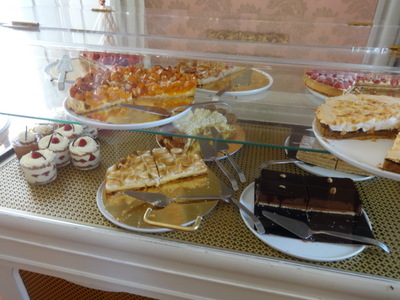
So does this long shot of the entrance to the museum's restaurant. To the left of the right-hand doorway (which leads into the main restaurant) you can see a glass case.
In the right-hand photo, you see a sampling of the desserts displayed in that case. They were intact when we entered but by the time we left, they were down to about half of their original sizes.
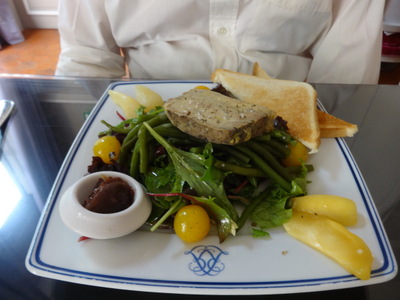
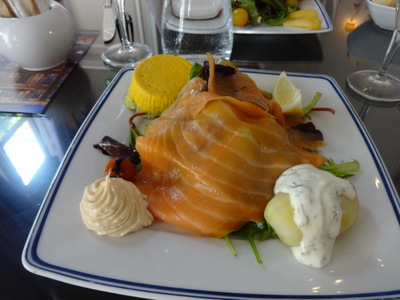 The restaurant itself was also beautifully decorated, but I didn't get a good photo of it. David ordered the Don Giovanni salad, topped with green beans, foie gras of duck on toast, and cherry tomatoes, accompanied by caramelized slices of apple and pear and a little dish of fig chutney.
The restaurant itself was also beautifully decorated, but I didn't get a good photo of it. David ordered the Don Giovanni salad, topped with green beans, foie gras of duck on toast, and cherry tomatoes, accompanied by caramelized slices of apple and pear and a little dish of fig chutney.
I chose Marriage of Figaro, draped with both smoked salmon and dill-marinated salmon and accompanied by a warm potato with a yogurt dressing on it, a puff of taramasalata, and at the back left, a little two-layered flan of vegetables flavored with dill. Both delicious.
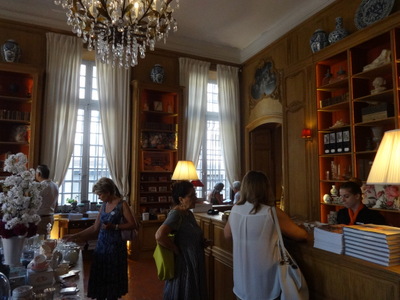
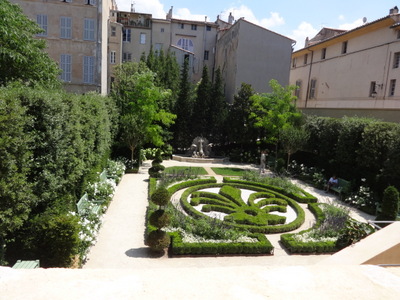 Finally, after another pass through the gift shop (left-hand photo) and a viewing of the Cezanne film, we just stuck our heads out into the garden for a quick look.
Finally, after another pass through the gift shop (left-hand photo) and a viewing of the Cezanne film, we just stuck our heads out into the garden for a quick look.
From street level, you looked down into this handsome formal layout of miniature hedges with a dolphin-decorated fountain at the back and white roses along the sides.
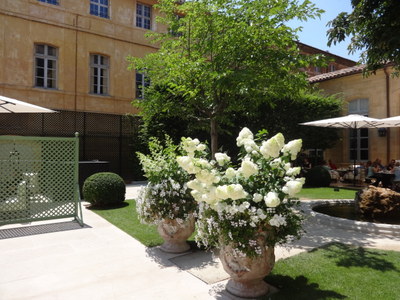
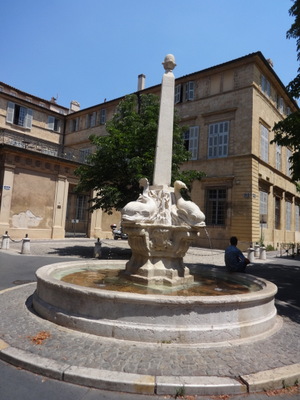 On street level, just outside the restaurant, were this planters full of magnificent hydrangeas. Gorgeous.
On street level, just outside the restaurant, were this planters full of magnificent hydrangeas. Gorgeous.
Then it was time to go. We took a different route back to the hotel, passing on the way the famous dolphin fountain we remembered from our previous visit.
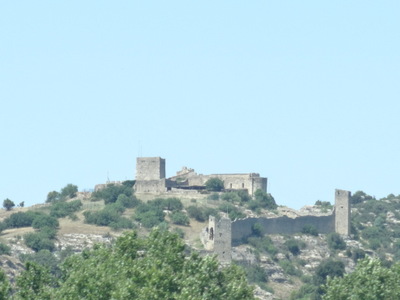
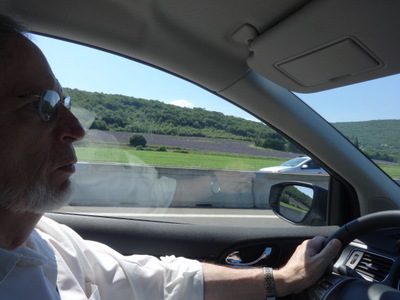 We dragged the luggage back to the garage, piled in, and set off for Valence, a city of 65,000 a good ways up the Rhône valley, the longest driving leg of the trip.
We dragged the luggage back to the garage, piled in, and set off for Valence, a city of 65,000 a good ways up the Rhône valley, the longest driving leg of the trip.
It was freeway virtually all the way. In fact, almost all our driving was on freeways on this trip (the exception being the hair-raising trip up the mountain to Megève and back down, of which more later), but I managed to get this photo of some ruins; we passed many such structures on the hills and mountains flanking the highway.
The right-hand photo, shot past David as he drove, shows a field of lavender in bloom. We passed quite a few, but lavender isn't very tall, and the weeds and shrubbery along the roads often blocked the view when we got abreast of them. Other fields were filled with corn, hay stubble with scattered bales, and sunflowers in full bloom.
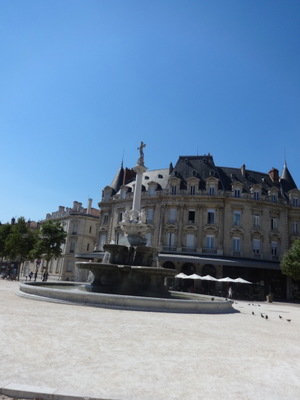
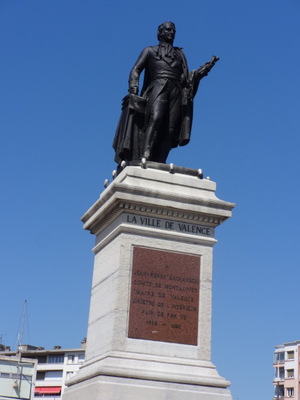 For once the GPS took us right to our hotel. We pulled up outside it at about 4 p.m. but saw no sign of the promised private parking, so I hopped out to ask only to find the door locked and a sign indicating that reception would not be open until 6 p.m. Drat.
For once the GPS took us right to our hotel. We pulled up outside it at about 4 p.m. but saw no sign of the promised private parking, so I hopped out to ask only to find the door locked and a sign indicating that reception would not be open until 6 p.m. Drat.
We pulled around the corner on a hunch, and sure enough, there was the parking lot, but the gate was locked. So we drove around a few corners until we found a parking spot on the street—free, even, because it was Sunday.
So lets go take a walk around to kill time, have a drink, and try again at 6 p.m. Once we walked a few blocks back toward the middle of town, we struck a broad avenue with even broader sidewalks, anchored at one end by this fountain (referred to on city signage as the "monumental fountain") and at the other by this monument to Jean-Pierre Bachasson, Comte de Montalivet (1766–1823), described as "Mayor or Valence, Minister of the Interior, and Peer of France.
One two-lane portion of the avenue was divided off from the rest by curbs and lined with bus stops; we had chanced on the city's bus hub. Those two lane, still reserved for buses and taxis, disappeared around curves at each end of the boulevard. I suspect they ring the city center, which is almost all pedestrian streets. The other lanes were two-way traffic for cars.
The boulevard's extra-wide sidewalks left room for both sidewalk caf&ecute; tables (which were numerous), a broad pedestrian section, and a series of little cube-shaped buildings with their backs to the bus stops. Some of the housed tiny restaurants (tacos, sushi, crepes, . . .), and one had been fitted out with bicycle lockers for people who either ride into the city on bikes, then walked to work in the city center or used a bike to get around the city center but came and went from it on the bus. Good idea. Nearby were several racks of those city-owned bikes that you borrow or rent by subscription. Another good idea.
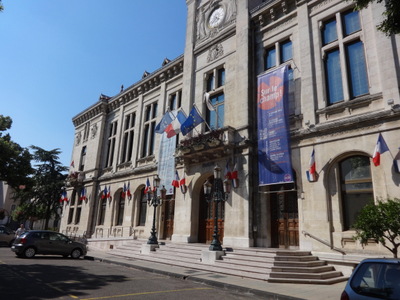
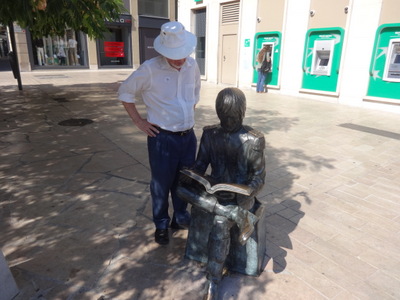 Continuing past the big boulevard, we found ourselves in the almost-entirely-pedestrian town center. The photo at the left is the city hall, which faces the equally handsome municipal theater across a little square.
Continuing past the big boulevard, we found ourselves in the almost-entirely-pedestrian town center. The photo at the left is the city hall, which faces the equally handsome municipal theater across a little square.
Down a side street, we found this statue of Napoleon as a 17-year-old corporal, when he was garrisoned here in Valence. I forget what the book says that he's reading (something prophetic, I'm sure), but David read it over his shoulder and could probably tell you. At the top left corner of the photo, you can make out a branch and flower of what we call mimosa back in Tallahassee but which is called "albizzia" here (from the genus name) to distinguish it from the famous yellow mimosas (genus Acacia) of the south of France.
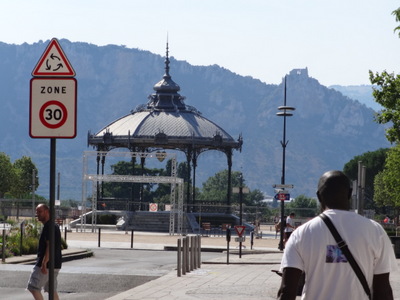
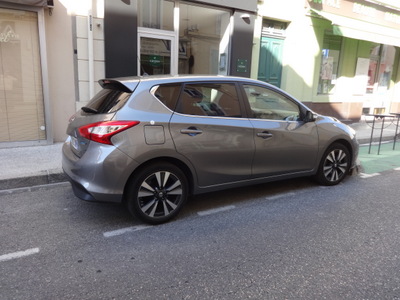 At the farthest point of our walk, we had this view of the "kiosk," now a national historical momnument," partially obscured by scaffolding being set up for a concert (probably a propos of Bastille Day, coming up in a few days).
At the farthest point of our walk, we had this view of the "kiosk," now a national historical momnument," partially obscured by scaffolding being set up for a concert (probably a propos of Bastille Day, coming up in a few days).
In the course of our wanderings, we located a couple of luggage stores, an Orange store (Orange is France's principal phone network), and a FNAC (books and electronics). They were all closed, of course, on a Sunday afternoon, but they were conveniently all next to each other and easily relocated later.
Finally, we settled at a sidewalk café next to the monumental fountain. I had a split of Vittel (no Evian to be had), and David ordered an "icetea," which we were surprised to find on the menu. It was a little bottle, properly chilled, of Lipton peach-flavored iced tea. Pretty good, actually. He has ordered it frequently since, and we find it's pretty widely available (and always peach-flavored, though I think they make other varieties).
Before heading back to the car, we consulted a map of the neighborhood posted at the bus stops and were surprised to see that we were actually less than a block from our hotel! Of course, all the one-ways would make it a little tricky to get there from where the car was parked, but now that we knew where we were, we made it (no thanks to the GPS, which directed us down a small street blocked by hefty metal bollards). David waited in the car outside the locked parking lot gate while I walked around to reception (finally open) to get the code to open it. It was the best kind of parking—small, outdoor, behind a locked gate, and shaded!
The photo at the right is our car, a Nissan Pulse, as we parked it on the street for the afternoon.
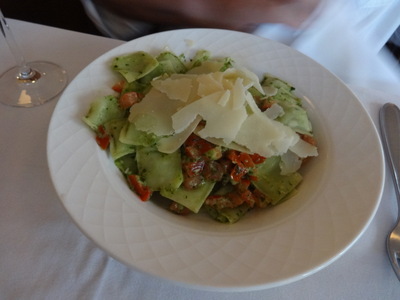
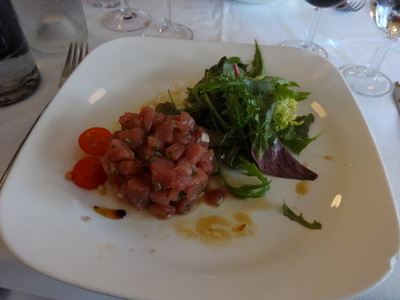 once we were settled in, David found that he had left his toothbrush behind in Aix, but I was able to produce one from my little kit of spares. We cleaned up, rested our feet for a while, and set out for our dinner at Bistro des Clercs (in the Place des Clercs, named for the religious order that used to occupy the nearby church; "clerc" means "clerk" but also "cleric"). The amuse-bouche was a little dish of ferociously flavorful wrinkled black olives.
once we were settled in, David found that he had left his toothbrush behind in Aix, but I was able to produce one from my little kit of spares. We cleaned up, rested our feet for a while, and set out for our dinner at Bistro des Clercs (in the Place des Clercs, named for the religious order that used to occupy the nearby church; "clerc" means "clerk" but also "cleric"). The amuse-bouche was a little dish of ferociously flavorful wrinkled black olives.
David started with "ravioles du dauphiné" (i.e., ravioli of the dauphiné region) with pesto and diced tomato, with Parmesan shavings on top. He got the "small" appetizer portion and couldn't finish it; who knows what the large appetizer portion is like! These little ravioli are everywhere in the region we covered this year (and we'd run across them in Lyon on previous trips). They vary from about half an inch square to the size of postage stamps and are filled with a mixture of Comté or Emmenthal cheese, "fromage blanc" (a fresh cheese with no American equivalent), and parsley, so they're always greenish. They're sauced all kinds of ways and even served cold in salads.
I had this beautiful tuna tartare "with Asian flavors," most prominently a little ginger and lots of sesame oil. Very coarsely chopped and really yummy.
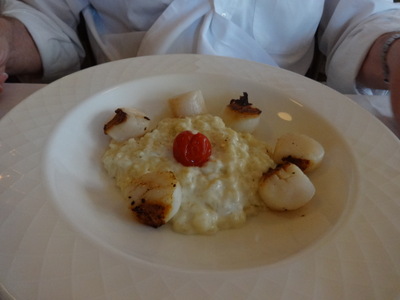
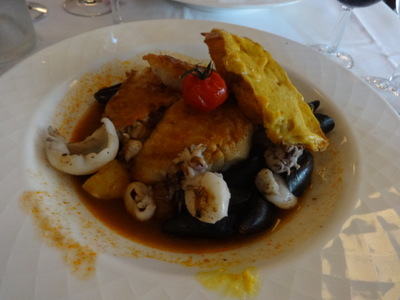 David's main course was scallops with risotto. The risotto was good, but he declared these the best scallops he's ever eaten (in a landlocked region; go figure).
David's main course was scallops with risotto. The risotto was good, but he declared these the best scallops he's ever eaten (in a landlocked region; go figure).
I had filet de rascasse (scorpion-fish, unfortunately ambiguous in French; it could refer to any of several fishes that aren't even in the same genus) in a seafood bouillon with mussels and baby octopus, topped with a slice of crisp toast spread with rouille ("rust," a garlicky saffron mayo). Very good, although the octopus was strangely tasteless; I though the first piece was pasta.
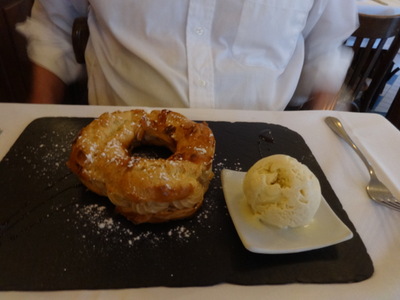
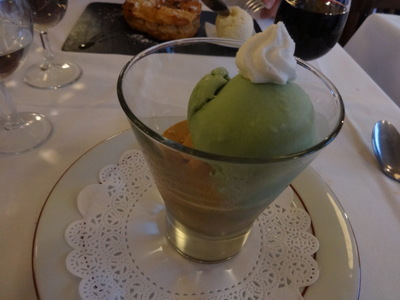 For dessert, David got a Paris-Brest, a ring-shaped (i.e., bicycle-tire-shaped) caramel-almond cream puff (named for the famous Paris-Brest bicycle race). I can't believe he ate the whole thing! And the ice cream too!
For dessert, David got a Paris-Brest, a ring-shaped (i.e., bicycle-tire-shaped) caramel-almond cream puff (named for the famous Paris-Brest bicycle race). I can't believe he ate the whole thing! And the ice cream too!
I kept it simple with coffee and pistachio ice cream topped with a tiny crisp meringue puff.
While we ate, noisy, not to say raucous, crowds streamed back and forth past the restaurant's windows. Wearing outlandish make-up and costumes and waving flags in preparation for the 9 p.m. soccer game between France and Portugal that would decide the European championship. Vuvuzelas were involved, as well as other noise-making devices.
Once the game started, the serious soccer fans settled somewhere—cafés, public squares with huge TVs set up, etc., and only the 10-year-old boys, drunk with excitement, continued to run around yelling.
Our restaurant did not have a TV set up, but most did. In fact, back in Aix, we walked past a small bistro that had posted a sign out from, "Ici, pas de FOOT!" (Here, no SOCCER!) for those wishing to escape the hype. The game was still going on when we went to bed.
Previous entry
List of Entries
Next entry

 Breakfast at the Concorde comes from this compact little buffet. It's anchored at one end by the coffee machine and at the other by the juice dispenser. In between are croissants, baguette chunks, sliced bread for the toaster, three kinds of cereal, and butter, jam, and nutella. The hostess brings each person a plain yogurt and a single-serve tub of applesauce. No decaf, so I chose tea, and I put apricot jam in my yogurt.
Breakfast at the Concorde comes from this compact little buffet. It's anchored at one end by the coffee machine and at the other by the juice dispenser. In between are croissants, baguette chunks, sliced bread for the toaster, three kinds of cereal, and butter, jam, and nutella. The hostess brings each person a plain yogurt and a single-serve tub of applesauce. No decaf, so I chose tea, and I put apricot jam in my yogurt.
 We were there, waiting for the opening gun, when we and the few others waiting with us saw advancing down the street a solid phalanx of at least 60 people, led by a guide in Carnaval Cruise livery. Oh, no! But fortunately, they were only pausing to look through the gates at the building and continued on by without lining up to go in.
We were there, waiting for the opening gun, when we and the few others waiting with us saw advancing down the street a solid phalanx of at least 60 people, led by a guide in Carnaval Cruise livery. Oh, no! But fortunately, they were only pausing to look through the gates at the building and continued on by without lining up to go in.
 In addition to the Turner exhibit, a couple of furnished rooms of the house itself were open. This one is the music room, and if we'd had time, we could have stood at the little computer terminal, touched the language of our choice, and heard all about its furniture.
In addition to the Turner exhibit, a couple of furnished rooms of the house itself were open. This one is the music room, and if we'd had time, we could have stood at the little computer terminal, touched the language of our choice, and heard all about its furniture.


 The restaurant itself was also beautifully decorated, but I didn't get a good photo of it. David ordered the Don Giovanni salad, topped with green beans, foie gras of duck on toast, and cherry tomatoes, accompanied by caramelized slices of apple and pear and a little dish of fig chutney.
The restaurant itself was also beautifully decorated, but I didn't get a good photo of it. David ordered the Don Giovanni salad, topped with green beans, foie gras of duck on toast, and cherry tomatoes, accompanied by caramelized slices of apple and pear and a little dish of fig chutney.
 Finally, after another pass through the gift shop (left-hand photo) and a viewing of the Cezanne film, we just stuck our heads out into the garden for a quick look.
Finally, after another pass through the gift shop (left-hand photo) and a viewing of the Cezanne film, we just stuck our heads out into the garden for a quick look.
 On street level, just outside the restaurant, were this planters full of magnificent hydrangeas. Gorgeous.
On street level, just outside the restaurant, were this planters full of magnificent hydrangeas. Gorgeous.

 We dragged the luggage back to the garage, piled in, and set off for Valence, a city of 65,000 a good ways up the Rhône valley, the longest driving leg of the trip.
We dragged the luggage back to the garage, piled in, and set off for Valence, a city of 65,000 a good ways up the Rhône valley, the longest driving leg of the trip.
 For once the GPS took us right to our hotel. We pulled up outside it at about 4 p.m. but saw no sign of the promised private parking, so I hopped out to ask only to find the door locked and a sign indicating that reception would not be open until 6 p.m. Drat.
For once the GPS took us right to our hotel. We pulled up outside it at about 4 p.m. but saw no sign of the promised private parking, so I hopped out to ask only to find the door locked and a sign indicating that reception would not be open until 6 p.m. Drat.
 Continuing past the big boulevard, we found ourselves in the almost-entirely-pedestrian town center. The photo at the left is the city hall, which faces the equally handsome municipal theater across a little square.
Continuing past the big boulevard, we found ourselves in the almost-entirely-pedestrian town center. The photo at the left is the city hall, which faces the equally handsome municipal theater across a little square. 
 At the farthest point of our walk, we had this view of the "kiosk," now a national historical momnument," partially obscured by scaffolding being set up for a concert (probably a propos of Bastille Day, coming up in a few days).
At the farthest point of our walk, we had this view of the "kiosk," now a national historical momnument," partially obscured by scaffolding being set up for a concert (probably a propos of Bastille Day, coming up in a few days).
 once we were settled in, David found that he had left his toothbrush behind in Aix, but I was able to produce one from my little kit of spares. We cleaned up, rested our feet for a while, and set out for our dinner at Bistro des Clercs (in the Place des Clercs, named for the religious order that used to occupy the nearby church; "clerc" means "clerk" but also "cleric"). The amuse-bouche was a little dish of ferociously flavorful wrinkled black olives.
once we were settled in, David found that he had left his toothbrush behind in Aix, but I was able to produce one from my little kit of spares. We cleaned up, rested our feet for a while, and set out for our dinner at Bistro des Clercs (in the Place des Clercs, named for the religious order that used to occupy the nearby church; "clerc" means "clerk" but also "cleric"). The amuse-bouche was a little dish of ferociously flavorful wrinkled black olives.
 David's main course was scallops with risotto. The risotto was good, but he declared these the best scallops he's ever eaten (in a landlocked region; go figure).
David's main course was scallops with risotto. The risotto was good, but he declared these the best scallops he's ever eaten (in a landlocked region; go figure).
 For dessert, David got a Paris-Brest, a ring-shaped (i.e., bicycle-tire-shaped) caramel-almond cream puff (named for the famous Paris-Brest bicycle race). I can't believe he ate the whole thing! And the ice cream too!
For dessert, David got a Paris-Brest, a ring-shaped (i.e., bicycle-tire-shaped) caramel-almond cream puff (named for the famous Paris-Brest bicycle race). I can't believe he ate the whole thing! And the ice cream too!